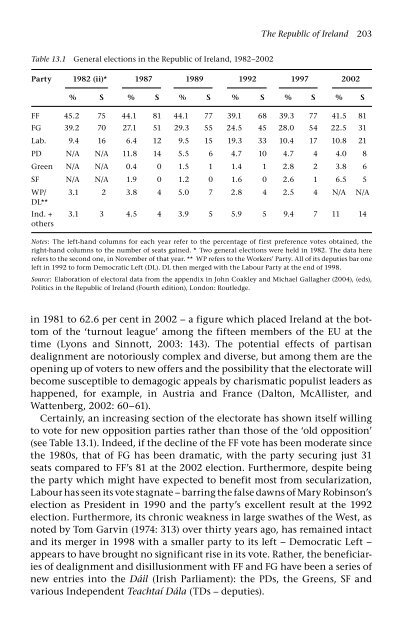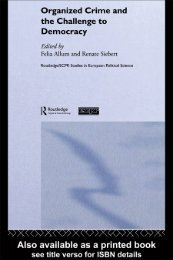Twenty-First Century Populism: The Spectre of Western European ...
Twenty-First Century Populism: The Spectre of Western European ...
Twenty-First Century Populism: The Spectre of Western European ...
You also want an ePaper? Increase the reach of your titles
YUMPU automatically turns print PDFs into web optimized ePapers that Google loves.
Table 13.1 General elections in the Republic <strong>of</strong> Ireland, 1982–2002<br />
<strong>The</strong> Republic <strong>of</strong> Ireland 203<br />
Party 1982 (ii)* 1987 1989 1992 1997 2002<br />
% S % S % S % S % S % S<br />
FF 45.2 75 44.1 81 44.1 77 39.1 68 39.3 77 41.5 81<br />
FG 39.2 70 27.1 51 29.3 55 24.5 45 28.0 54 22.5 31<br />
Lab. 9.4 16 6.4 12 9.5 15 19.3 33 10.4 17 10.8 21<br />
PD N/A N/A 11.8 14 5.5 6 4.7 10 4.7 4 4.0 8<br />
Green N/A N/A 0.4 0 1.5 1 1.4 1 2.8 2 3.8 6<br />
SF N/A N/A 1.9 0 1.2 0 1.6 0 2.6 1 6.5 5<br />
WP/<br />
DL**<br />
3.1 2 3.8 4 5.0 7 2.8 4 2.5 4 N/A N/A<br />
Ind. +<br />
others<br />
3.1 3 4.5 4 3.9 5 5.9 5 9.4 7 11 14<br />
Notes: <strong>The</strong> left-hand columns for each year refer to the percentage <strong>of</strong> first preference votes obtained, the<br />
right-hand columns to the number <strong>of</strong> seats gained. * Two general elections were held in 1982. <strong>The</strong> data here<br />
refers to the second one, in November <strong>of</strong> that year. ** WP refers to the Workers’ Party. All <strong>of</strong> its deputies bar one<br />
left in 1992 to form Democratic Left (DL). DL then merged with the Labour Party at the end <strong>of</strong> 1998.<br />
Source: Elaboration <strong>of</strong> electoral data from the appendix in John Coakley and Michael Gallagher (2004), (eds),<br />
Politics in the Republic <strong>of</strong> Ireland (Fourth edition), London: Routledge.<br />
in 1981 to 62.6 per cent in 2002 − a figure which placed Ireland at the bottom<br />
<strong>of</strong> the ‘turnout league’ among the fifteen members <strong>of</strong> the EU at the<br />
time (Lyons and Sinnott, 2003: 143). <strong>The</strong> potential effects <strong>of</strong> partisan<br />
dealign ment are notoriously complex and diverse, but among them are the<br />
opening up <strong>of</strong> voters to new <strong>of</strong>fers and the possibility that the electorate will<br />
become susceptible to demagogic appeals by charismatic populist leaders as<br />
happened, for example, in Austria and France (Dalton, McAllister, and<br />
Wattenberg, 2002: 60−61).<br />
Certainly, an increasing section <strong>of</strong> the electorate has shown itself willing<br />
to vote for new opposition parties rather than those <strong>of</strong> the ‘old opposition’<br />
(see Table 13.1). Indeed, if the decline <strong>of</strong> the FF vote has been moderate since<br />
the 1980s, that <strong>of</strong> FG has been dramatic, with the party securing just 31<br />
seats compared to FF’s 81 at the 2002 election. Furthermore, despite being<br />
the party which might have expected to benefit most from secularization,<br />
Labour has seen its vote stagnate − barring the false dawns <strong>of</strong> Mary Robinson’s<br />
election as President in 1990 and the party’s excellent result at the 1992<br />
election. Furthermore, its chronic weakness in large swathes <strong>of</strong> the West, as<br />
noted by Tom Garvin (1974: 313) over thirty years ago, has remained intact<br />
and its merger in 1998 with a smaller party to its left − Democratic Left −<br />
appears to have brought no significant rise in its vote. Rather, the beneficiaries<br />
<strong>of</strong> dealignment and disillusionment with FF and FG have been a series <strong>of</strong><br />
new entries into the Dáil (Irish Parliament): the PDs, the Greens, SF and<br />
various Independent Teachtaí Dála (TDs – deputies).



